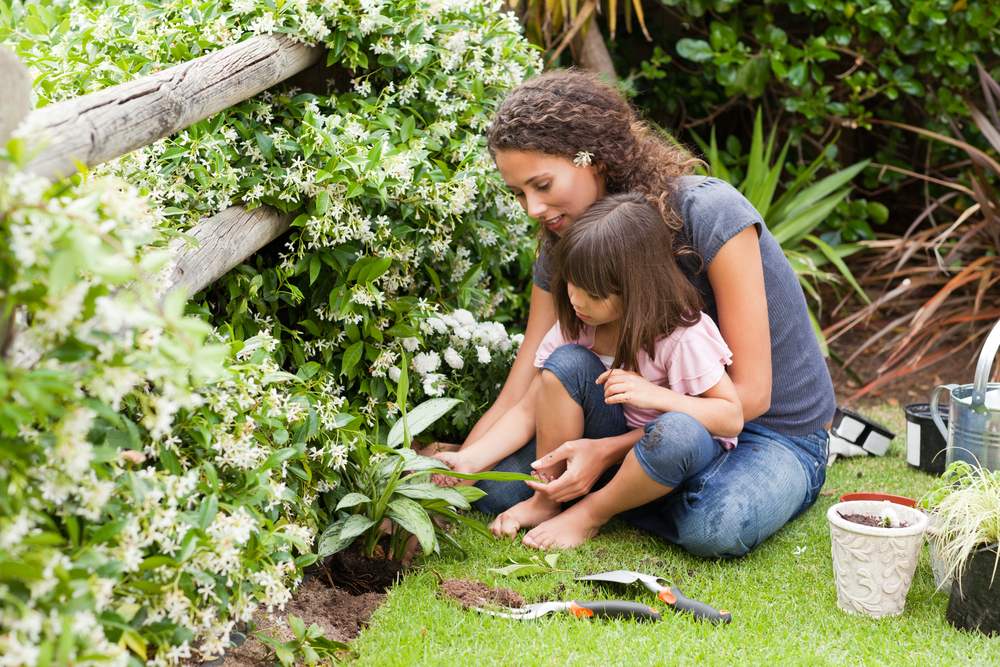
First let’s review what you learned in Week Three:
Last week you learned all about the nutrients plants need to grow and how the energy and nutrients stored in plants help people grow and stay healthy. Did you do any of the activities from last week? In the Bottles Up soil activity, you learned about the different size particles in your soil. What is in your soil?
What did you learn about carrots? Did you watch the Oregon Harvest Video? Tell us what you learned here.
If you were one of the first 125 families to register, you should have picked up your nutrition and garden activity kits last week. If you haven’t picked up your kits yet, check with your school to see if you can pick them up this week.
Check out this video explaining what’s in your garden activity kits:
We have created a Photo Gallery sharing page so you can let your friends and others see what you are learning and exploring. Use the upload link to submit your photo! Here’s how to submit and the guidelines:
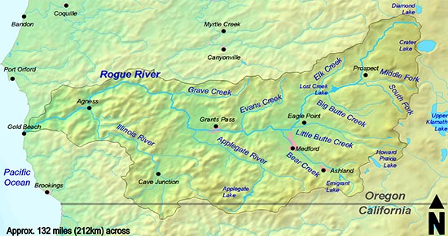 We live in the Rogue River Watershed. The Rogue River starts from three branches near the crest of the Cascade Mountains above the town of Prospect.
We live in the Rogue River Watershed. The Rogue River starts from three branches near the crest of the Cascade Mountains above the town of Prospect.
It passes through Prospect, Eagle Point, Grants Pass and Agness on the 215-mile journey to the Pacific Ocean at Gold Beach.
Photo credit: explore.globalcreations.com
This map shows many of the smaller rivers and tributaries that join the Rogue. Communities are dependent on the Rogue River watershed for clean water to support people, plants, wildlife, livestock, agriculture and recreation.
Maintaining the health of the watershed is vital to the health of our local ecosystem, to native fish like salmon and steelhead and you!
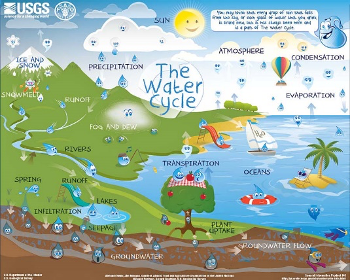 The Water Cycle explains how Earth’s water is always changing forms, between liquid (rain), solid (ice) and gas (vapor) but also moving on, above and in the Earth.
The Water Cycle explains how Earth’s water is always changing forms, between liquid (rain), solid (ice) and gas (vapor) but also moving on, above and in the Earth.
This process is always happening everywhere.
This interactive diagram provided by USGS Water Sciences School allows you to move mouse over the words to learn about these processes – try this by visiting - https://water.usgs.gov/edu/watercycle-kids-int.html
You can also do a water cycle activity in your Jr. Master Gardener Handbook on page 36.
Last week you learned about roots and nutrients. Plants use their roots to take water and dissolved nutrients from the ground up into the stem, leaves, and fruits. Plants need water to be healthy and productive.
Water is drawn through the plants and back into the air through the process of transpiration. You can demonstrate this by tying a clear plastic bag over a small group of leaves on a tree or bush. Use a piece of string or tape to tie the opening of the bag around the stem. Check back in a few hours to see the water drops in the bag. Where did this water come from? (From JMG Handbook page 37).
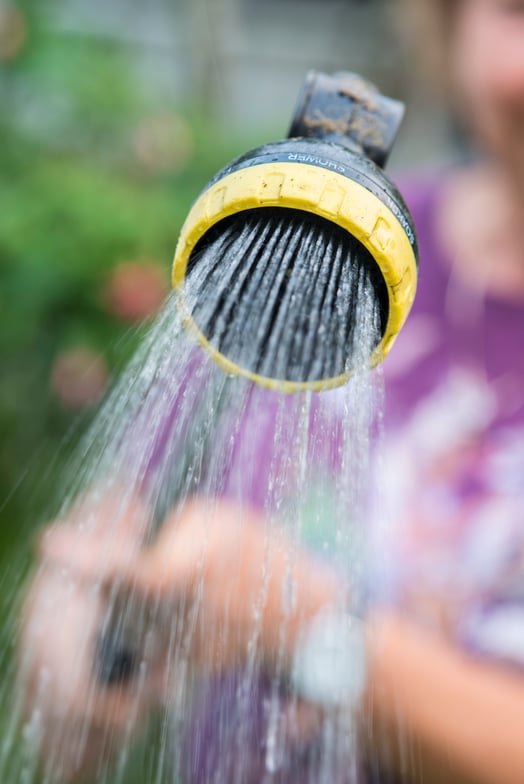 Plants in nature get most of their water from rainfall. Here in Southern Oregon, it doesn’t rain much in the summer.
Plants in nature get most of their water from rainfall. Here in Southern Oregon, it doesn’t rain much in the summer.
Gardens, especially vegetable gardens, need to be watered regularly during the summer.
When we water plants it is called irrigation. There are different ways to irrigate plants. You can use overhead sprinkling to mimic rainfall, either with a watering can, hose, or sprinkler.
Flood irrigation is another way to provide water directly to the plants roots without getting the leaves wet. In a small garden, you can do this with a watering can or a hose. Remember to water gently at the base of the plant. You don’t want to blast the soil, seeds or roots with a strong stream of water.
You can also use a soaker hose or drip irrigation to slowly provide water to the soil.
Do the Water Works activity on page 39 in the Jr. MG handbook to experiment with different types of irrigation.
Copyright OSU 2014, Photo Credit Lynn Ketchum
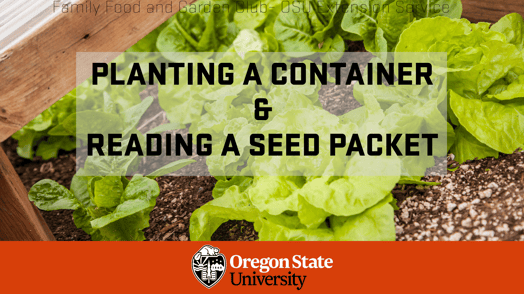 If you picked up your garden activity kit last week you are probably excited to start planting. In this slide show, we will walk you through the steps of planting a small container garden.
If you picked up your garden activity kit last week you are probably excited to start planting. In this slide show, we will walk you through the steps of planting a small container garden.
You will also learn how to read a seed packet.
Find the seed packets from your activity kit and see if you can answer these questions about your seeds.
• What type of plant will grow from this seed?
• What variety is it?
• How long will it take to grow from seed to a mature plant?
• How far apart should the plants be spaced so they have enough room when they are full-grown?
• How deep should you plant the seed?
Water is one of the body’s most essential nutrients. People may survive six weeks without food but could not live more than a week or so without water. All of the functions in our body depend on H2O (water) as a key part of the daily biochemical reactions that keep us alive.
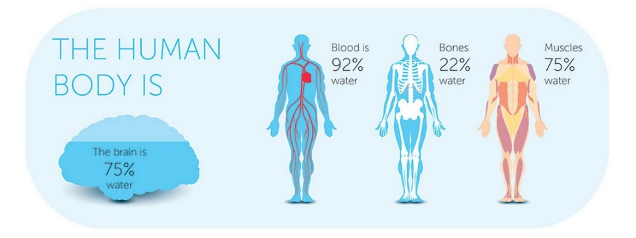
What does water do for you?
• Keeps body temperature normal through sweat and breathing
• Forms saliva and keeps internal body tissues and membranes moist
• Converts food through digestion to nutrients your body needs for survival
• Helps deliver oxygen all over the body through the blood and lungs
• Helps your body get rid of waste through urination, perspiration and bowel movements
• Cushions and protects brain and spinal cord
• Lubricates joints
• Brain needs water to make hormones and neurotransmitters
At birth, a baby’s body is about 78% water. By age 1, the amount drops to about 65%. Kids have higher percentage of water than adults do. Adult women have about 55% and men about 60% body weight as water. These differences are why we need slightly different amounts of fluid each day to keep from becoming dehydrated.
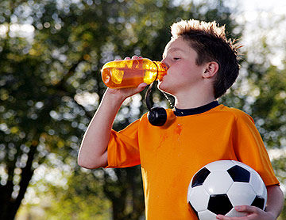 Stay Hydrated – Aim for around 8 cups of water or other fluids each day- more if you are active and during hot weather.
Stay Hydrated – Aim for around 8 cups of water or other fluids each day- more if you are active and during hot weather.
Some tips:
• Drink water or low-fat milk with meals.
• Keep water handy in a reusable water bottle for home and out and about
• Choose water when eating away from home
• Drink water before, during and after exercising
• Jazz-up water with a squeeze of lemon or lime
• Herbal teas either hot or iced
• Try sugar-free sparkling water with a splash of fruit juice
source: Parents.com
Why do we sweat? Another great scientific explanation from the SciShow Kids expert Jessi.
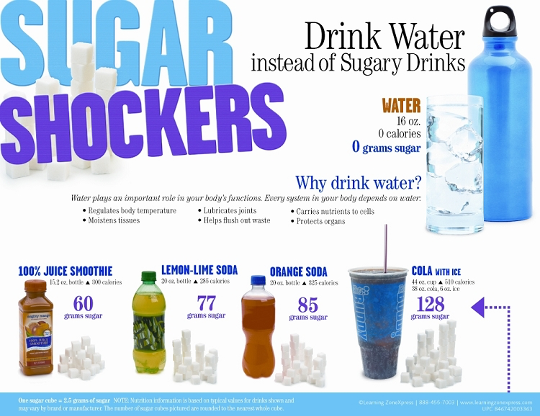
Source: Learning Zone Express
How Sweet? One teaspoon of sugar contains 4.2 grams. Imagine adding 7-10 teaspoons of sugar to a 12-ounce cup of water. Does that sound too sweet?
This image shows how much added sugar is in a can of soda. Energy drinks have as much sugar as soda and usually lots of caffeine and other additives that are not healthy! Sports drinks to replenish glucose, fluids, and electrolytes (sodium, potassium, magnesium, calcium) are usually not necessary for active kids. Water and a snack after exercise should be just what you need!
Sugary drinks like soda, sports drinks, and energy drinks—offer hydration but also extra calories and not much nutrition. Extra calories can lead to overweight, tooth decay and other health problems. Milk and 100% fruit juice contain natural sugars, but also give you calcium, Vitamin D and Vitamin C and B- vitamins too.
An easy and fun way to observe how plants move water around inside them is by using the color-changing celery experiment. In this video, our friends from SciShow Kids explain how to set up your own experiment at home. Let’s watch –
Try this experiment using celery, a flower or another plant found in your refrigerator, yard or garden. Or you can try it with two different plants and observe the similarities and differences in how the colored water moves through the plant. Draw what happened or photograph results to include in your weekly journal.
#1 Color-Changing Celery experiment
• Plant stems like celery or the stalk of a flower are the part of the plant that moves nutrients from the soil and water throughout the plant. Compare how this works in plants to how it works in your body. How are the nutrients that come from the food you eat transported in your body?
• How are plants and people similar? How are we different?
Can you think of any stems of plants that we eat? How many have you tried?
• Have you ever tried rhubarb? Did you like it?
#2 Rethink your Drink
• Use the Nutrition Facts Scavenger Hunt worksheet to figure out how much sugar is in a single serving of a drink.
• Check out Show Me the Sugar to help you identify different names for sugar.
• How Much Sugar and Calculating grams to teaspoons are helpful too.
Water touches every part of our lives- the cells in our bodies, the food we eat, the recreational activities that we enjoy, the weather that affects our daily lives and much more!
Project Wet has created this cool website with games, science experiments so if you want to explore more about watersheds, ocean habitats, the water cycle and water for people - check it out at https://www.discoverwater.org/
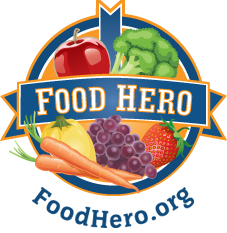 Keeping with this week’s focus on water use the Food Hero Drink Water your Way and enlist your child’s help and creativity to make fresh fruit or herbal ice cubes or try infusing water with fruits or vegetables. Cucumber mint is a favorite blend!
Keeping with this week’s focus on water use the Food Hero Drink Water your Way and enlist your child’s help and creativity to make fresh fruit or herbal ice cubes or try infusing water with fruits or vegetables. Cucumber mint is a favorite blend!
Check out these tips for making infused water for a crowd.
Your child can use their colander, cutting board, measuring spoons and water bottle provided in the Family Food kit to help make flavored water. The Food Hero newsletters are only the tip of the iceberg… the sky is the limit so try something new.
To learn more about the health aspects of beverage choices including coffee, tea, sports & energy drinks, and low-calorie sugar substitutes check out The Nutrition Source from Harvard T.H. Chan School of Public Health.
Out and About - Enjoy a social distancing family hike, walk or picnic along a river, stream or lake in the Rogue River watershed. Some favorite locations with short loop trails close to town are Limpy Creek, Waters Creek and Taylor Creek.
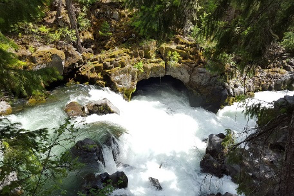 If you are ok with driving further, try Little Falls loop on the Illinois River, Avenue of the Boulders near Prospect, Willow, Diamond or Crater Lake or any of the trails access points on the Upper Rogue River off Oregon highway 62.
If you are ok with driving further, try Little Falls loop on the Illinois River, Avenue of the Boulders near Prospect, Willow, Diamond or Crater Lake or any of the trails access points on the Upper Rogue River off Oregon highway 62.
In and near Grants Pass you can enjoy one of our beautiful city or county parks like Riverside, Indian Mary, Fish Hatchery or Tom Pierce. Bring plenty of drinking water and a healthy picnic for an inexpensive family outing.
Natural Bridge on upper Rogue River
Play Hard Use the green flying disc (from your kit) or your own Frisbee to play these games with your family, friends or furry friend!
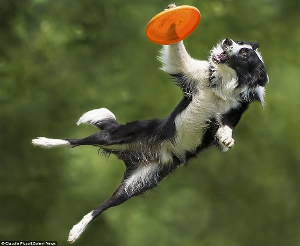 Frisbee Steps: Pass the disc back and forth. For each successful catch, both players take one-step back. Take one-step in for missed catches.
Frisbee Steps: Pass the disc back and forth. For each successful catch, both players take one-step back. Take one-step in for missed catches.
Frisbee Bocce: Play outdoors on a flat grassy surface. The game starts with someone throwing a tennis ball or baseball so it lands 10-30 feet away (a cardboard target could also be used). Participants take turns trying to land the flying disc as close to the target as possible. A player who manages to hit the target automatically wins the round, otherwise the closest throw wins. Each win scores 1 point. First player to score 5 points is the winner of the game.
Frisbee Sticks: Insert two sticks of similar size into the ground approximately 10-20 paces apart. Each player stands behind one of the sticks. Take turns throwing the disc across to your opponent’s stick. 5 points awarded for a direct hit and 1 point scored for any catches made from a missed throw – you must toss from behind the stick on your side. Players may not put any body part in front of the stick to defend it.

Oregon Agriculture in the Classroom is inviting students in grades K-6 to a live virtual visit to Tom’s Berry Patch in Forest Grove with berry farmer Kristin Vance to learn all about how she grows and cares for her crops, irrigation and machinery used for harvesting.
This Virtual Field Trip will take place on June 4 at 10:00 a.m. for 30 minutes with a ten-minute question period at the end. Learn more here - http://ow.ly/s4nz50zLQJI
